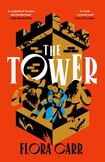
Of the many British regal houses, the Tudors and Windsors appear to be the most ruthless in their dealings with each other, which perhaps explains why they dominate literature, film and television in the way they do. From rogue claimants to 16th-century thrones through to the heart-rending travails of the Montecito Two, readers and viewers lap up their stories. I won’t lie; I’m one of them.
Strictly speaking, Mary Queen of Scots, the heroine of Flora Carr’s debut novel, was a Stuart, but when she succeeded to her throne, six days after her birth, her great-uncle Henry VIII ruled England, and when she was forced to abdicate 25 years later, the Elizabethan era was in full flow.
The Tower takes place between 1567 and 1568, when Mary was held captive at Lochleven Castle. It’s no mean feat to set most of a novel in a single room – just ask Emma Donoghue – but Carr succeeds admirably in depicting the joylessness of Mary’s incarceration and the various indignities to which she is subjected.
Terror hangs over every page. Although Mary surrenders her throne early on, her captors understand that a week is a long time in politics and a crown quickly stolen can be swiftly reclaimed. And so, like a failed candidate for the Republican presidential nomination, they remain careful to offer small kindnesses like a small prie-dieu in case a monarch’s restoration leads to brutal vengeance upon those who previously brought them low.
READ MORE
Mary’s life is depicted as utterly miserable. Married, remarried, and remarried again to men who either raped or abandoned her, she pines for her infant son. A miscarriage of twins is recounted in language so raw that the reader wonders how any woman could survive such trauma. Meanwhile, the occasional scribbled note from Elizabeth, who both fears and honours her cousin as an anointed queen, provides insight into wider mischief.
Carr draws us tightly into the skulduggery of the tower, building a gripping and claustrophobic read. Only the epilogue seems ill-advised; a few pages devoted to what happened to the various characters in the years leading to Mary’s execution reads as non-fiction, while the chapter that precedes it ends so poetically that it made me long for a second instalment.
















